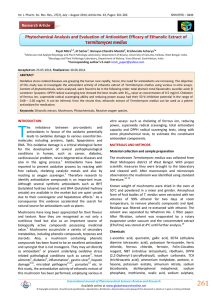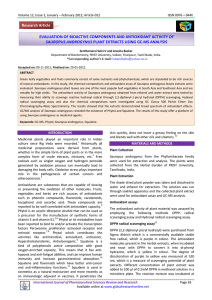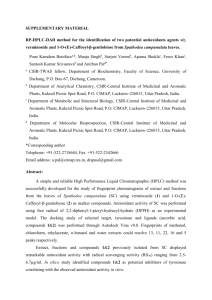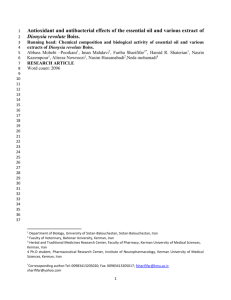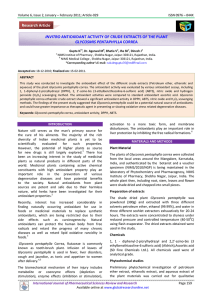Document 13309917
advertisement
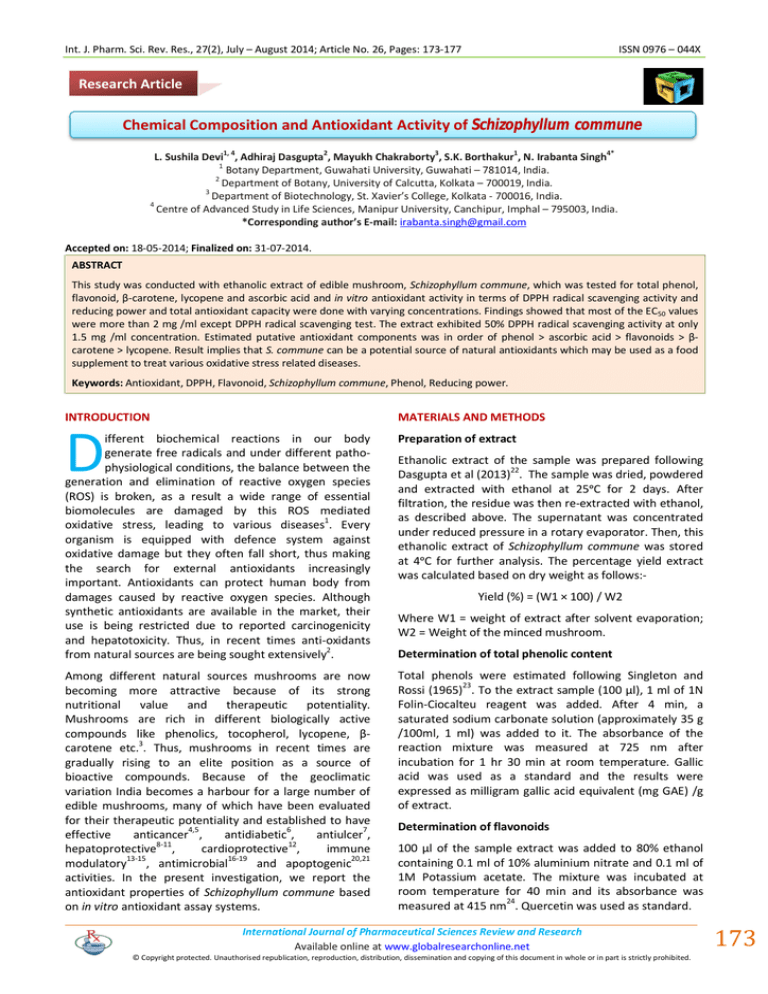
Int. J. Pharm. Sci. Rev. Res., 27(2), July – August 2014; Article No. 26, Pages: 173-177
ISSN 0976 – 044X
Research Article
Chemical Composition and Antioxidant Activity of Schizophyllum commune
1, 4
2
3
1
4*
L. Sushila Devi , Adhiraj Dasgupta , Mayukh Chakraborty , S.K. Borthakur , N. Irabanta Singh
1
Botany Department, Guwahati University, Guwahati – 781014, India.
2
Department of Botany, University of Calcutta, Kolkata – 700019, India.
3
Department of Biotechnology, St. Xavier’s College, Kolkata - 700016, India.
4
Centre of Advanced Study in Life Sciences, Manipur University, Canchipur, Imphal – 795003, India.
*Corresponding author’s E-mail: irabanta.singh@gmail.com
Accepted on: 18-05-2014; Finalized on: 31-07-2014.
ABSTRACT
This study was conducted with ethanolic extract of edible mushroom, Schizophyllum commune, which was tested for total phenol,
flavonoid, β-carotene, lycopene and ascorbic acid and in vitro antioxidant activity in terms of DPPH radical scavenging activity and
reducing power and total antioxidant capacity were done with varying concentrations. Findings showed that most of the EC50 values
were more than 2 mg /ml except DPPH radical scavenging test. The extract exhibited 50% DPPH radical scavenging activity at only
1.5 mg /ml concentration. Estimated putative antioxidant components was in order of phenol > ascorbic acid > flavonoids > βcarotene > lycopene. Result implies that S. commune can be a potential source of natural antioxidants which may be used as a food
supplement to treat various oxidative stress related diseases.
Keywords: Antioxidant, DPPH, Flavonoid, Schizophyllum commune, Phenol, Reducing power.
INTRODUCTION
MATERIALS AND METHODS
D
ifferent biochemical reactions in our body
generate free radicals and under different pathophysiological conditions, the balance between the
generation and elimination of reactive oxygen species
(ROS) is broken, as a result a wide range of essential
biomolecules are damaged by this ROS mediated
oxidative stress, leading to various diseases1. Every
organism is equipped with defence system against
oxidative damage but they often fall short, thus making
the search for external antioxidants increasingly
important. Antioxidants can protect human body from
damages caused by reactive oxygen species. Although
synthetic antioxidants are available in the market, their
use is being restricted due to reported carcinogenicity
and hepatotoxicity. Thus, in recent times anti-oxidants
2
from natural sources are being sought extensively .
Preparation of extract
Among different natural sources mushrooms are now
becoming more attractive because of its strong
nutritional value and therapeutic potentiality.
Mushrooms are rich in different biologically active
compounds like phenolics, tocopherol, lycopene, βcarotene etc.3. Thus, mushrooms in recent times are
gradually rising to an elite position as a source of
bioactive compounds. Because of the geoclimatic
variation India becomes a harbour for a large number of
edible mushrooms, many of which have been evaluated
for their therapeutic potentiality and established to have
effective
anticancer4,5,
antidiabetic6,
antiulcer7,
8-11
12
hepatoprotective ,
cardioprotective ,
immune
13-15
16-19
20,21
modulatory , antimicrobial
and apoptogenic
activities. In the present investigation, we report the
antioxidant properties of Schizophyllum commune based
on in vitro antioxidant assay systems.
Total phenols were estimated following Singleton and
Rossi (1965)23. To the extract sample (100 µl), 1 ml of 1N
Folin-Ciocalteu reagent was added. After 4 min, a
saturated sodium carbonate solution (approximately 35 g
/100ml, 1 ml) was added to it. The absorbance of the
reaction mixture was measured at 725 nm after
incubation for 1 hr 30 min at room temperature. Gallic
acid was used as a standard and the results were
expressed as milligram gallic acid equivalent (mg GAE) /g
of extract.
Ethanolic extract of the sample was prepared following
Dasgupta et al (2013)22. The sample was dried, powdered
and extracted with ethanol at 25ᵒC for 2 days. After
filtration, the residue was then re-extracted with ethanol,
as described above. The supernatant was concentrated
under reduced pressure in a rotary evaporator. Then, this
ethanolic extract of Schizophyllum commune was stored
at 4ᵒC for further analysis. The percentage yield extract
was calculated based on dry weight as follows:Yield (%) = (W1 × 100) / W2
Where W1 = weight of extract after solvent evaporation;
W2 = Weight of the minced mushroom.
Determination of total phenolic content
Determination of flavonoids
100 µl of the sample extract was added to 80% ethanol
containing 0.1 ml of 10% aluminium nitrate and 0.1 ml of
1M Potassium acetate. The mixture was incubated at
room temperature for 40 min and its absorbance was
24
measured at 415 nm . Quercetin was used as standard.
International Journal of Pharmaceutical Sciences Review and Research
Available online at www.globalresearchonline.net
© Copyright protected. Unauthorised republication, reproduction, distribution, dissemination and copying of this document in whole or in part is strictly prohibited.
173
Int. J. Pharm. Sci. Rev. Res., 27(2), July – August 2014; Article No. 26, Pages: 173-177
Determination of β-carotene and lycopene
For β-carotene and lycopene determination, 100 µl of the
sample extract was vigorously shaken with 10 ml of an
acetone–hexane mixture (4:6) for 1 min and filtered
through Whatman No. 4 filter paper. The absorbance of
the filtrate was measured at 453, 505, and 663 nm25. βcarotene and lycopene content were calculated according
to the following equations:Lycopene (mg /100 ml) = -0.0458×A663 + 0.372×A505 0.0806×A453
β-carotene (mg /100 ml) = 0.216×A663 0.304×A505 +
0.452×A453
The results are expressed as mg of carotenoid/g of
extract.
Ascorbic acid content determination
Ascorbic acid content was determined following Rekha et
al (2012)26 with a little modification. Standard ascorbic
acid (100 µg /ml) was taken in a conical flask and made up
to 10 ml by 0.6% oxalic acid. It was titrated with a dye, 2,
6-dichlorophenol indophenol. The amount of dye
consumed (V1 ml) is equivalent to the amount of ascorbic
acid. The sample (w µg /ml) was similarly titrated with the
dye (V2 ml). The amount of ascorbic acid was calculated
using the formula:Ascorbic acid (µg /mg) = [{(10 µg /V1ml) × V2 ml} × w µg]
× 1000
ISSN 0976 – 044X
mixture was prepared using different concentrations of
sample (1 - 2.5 mg /ml) and methanol solution of DPPH
(0.004 %) (w /v). The absorbance was read against a
methanol blank at 517 nm after 30 min incubation at
room temperature in dark. The degree of scavenging was
calculated by the following equation:Scavenging effect (%) = {(α0-α1) / α0} × 100
where α0 and α1 were the absorbance of control and in
presence of sample.
Determination of total antioxidant capacity (TAC)
The TAC was determined on the basis of reduction of Mo
(VI) to Mo (V) by the antioxidant compound and the
formation of green phosphate /Mo (V) complex at acidic
pH. Total antioxidant capacity of the sample was
investigated and compared against ascorbic acid. The TAC
of the sample was determined by the assay prescribed by
Preito et al (1999)29 with little modifications. A reaction
mixture was prepared consisting of 0.3 ml of reagent
solution (0.6 M H2SO4, 28 mM Na2SO4, 4 mM NH4Mo).
Absorbance was measured at 695 nm after heating tubes
at 95ᵒC for 90 min. Ascorbic Acid was used to draw a
standard curve and TAC was expressed as the equivalent
of ascorbic Acid.
Statistical analysis
Statistical analyses were done using MS Excel (Microsoft
Office 2010 Professional).
RESULTS AND DISCUSSION
Reducing power
Reducing power of the sample was determined following
Oyaizu (1986)27. Varied concentrations of the sample (0.5
- 2 mg /ml) were added to 2.5 ml of 0.2 M phosphate
buffer (pH 6.6) and 2.5 ml of 1% potassium ferricyanate.
2.5 ml of 10% trichloro acetic acid was added to the
mixture after an incubation of 20 min at 50˚C. It was then
centrifuged for 10 min at 12000 rpm. 2.5 ml of the
supernatant was mixed with distilled water and 0.5 ml of
0.1% ferric chloride. Its absorbance of the reaction
mixture was interpreted as an increase in reducing power
of the sample. Antioxidant has ability of donation of
electron and causes conversion of the oxidation form of
+3
+2
iron (Fe ) in ferric chloride to ferrous (Fe ). Resulting
Perl`s Prussian blue is measured at 700 nm and higher
absorbance indicates higher reducing power.
DPPH radical scavenging assay
The model of scavenging DPPH radical is a widely used
method to evaluate antioxidant activities in a relatively
short time compared with other methods. Effect of
antioxidants on DPPH free radicals is due to their
hydrogen donating ability. Upon reduction, solution of
DPPH fades from purple to yellow. Thus, a lower
absorbance at 517 nm indicates a higher radical
scavenging activity of extract. The DPPH radical
scavenging ability of the sample extract was measured
28
according to Shimada et al (1992) . 2 ml of reaction
Extractive value and estimation of phytochemicals
The studied fraction had an extractive value of 5.58%.
Phenol was present in the highest amount i.e. 12.5 ± 1.4
µg /mg of the sample. Flavonoid (1.78 ± 0.36 µg /mg) and
ascorbic acid (2.18 + 0.12 µg /mg) were present in
moderate amounts whereas β carotene (0.0136 ±
0.001µg/mg) and lycopene (0.011 ± 0.007µg /mg) were
present in trace amounts.
Phenolic compounds possess scavenging ability due to
their hydroxyl groups and are known to be powerful
antioxidant. In the present study, the total phenolic
content of S. commune was found higher than Pleurotus
30
31
ostreatus and Pleurotus citrinopileatus which were
reported to be 5.49 µg/mg and 8.62 µg/mg respectively.
The phenolic content was also found to be comparatively
higher than that of Russula albonigra (9.53 µg/mg) as
reported ealier32.
Reducing power
Reducing power of a compound indicates its potential
antioxidant activity. The reducers (i.e., antioxidants)
reduces Fe3+ /ferricyanide complex to ferrous form. The
yellow colour of the test solution is changed to various
shades of green and blue, depending on the reducing
power of the sample. S. commune was found to be a
potential reducing agent, having an EC50 value of 0.825
mg/ml (Fig 1). Compared to previously reported studies,
International Journal of Pharmaceutical Sciences Review and Research
Available online at www.globalresearchonline.net
© Copyright protected. Unauthorised republication, reproduction, distribution, dissemination and copying of this document in whole or in part is strictly prohibited.
174
Int. J. Pharm. Sci. Rev. Res., 27(2), July – August 2014; Article No. 26, Pages: 173-177
33
34
Hypsizigus marmoreus , Calocybe gambosa , Tricholoma
giganteum35, Russula albonigra32 Amanita vaginata36 had
slightly better reducing ability than S. commune. Thus, the
sample has excellent reducing ability.
1.5
1.3
Reducing power
1.1
0.9
0.7
0.5
0.3
0.1
-0.1
0.5
1
1.5
Concentration (mg/ml)
Ascorbic acid
(Ascorbic acid was used as the standard. Results are
mean ± standard deviation of three separate experiments
each in triplicate).
Total antioxidant capacity
Total antioxidant capacity of ethanolic fraction of S.
commune was determined by the formation of green
phosphomolybdenum complex. The phosphomolybdenum method is based on the reduction of Mo (VI) to
Mo (V) by the antioxidant compound and the formation
of green phosphate/Mo (V) complex with the maximal
absorption at 695 nm. Total antioxidant activity of the
extract was estimated, using ascorbic acid as standard. On
analysis, it was found that 0.1 mg of S. commune is as
functional as approximately 67 ± 8 µg of ascorbic acid,
expressed as 67 µg ascorbic acid equivalent (AAE).
CONCLUSION
S. commune
Figure 1: Reducing ability of ethanolic extract of S.
commune.
(Ascorbic acid was used as the standard. Results are
mean ± standard deviation of three separate experiments
each in triplicate).
DPPH radical scavenging assay
DPPH is a stable free radical that shows a characteristic
absorbance at 517 nm, which decreases significantly
when exposed to radical scavengers by providing
hydrogen atom or electron to be a stable diamagnetic
molecule. Ethanolic fraction of S. commune had an EC50
value of 0.883 mg /ml (Fig 2) which indicates the potent
DPPH radical scavenging potential of the extract. In
comparison, the DPPH radical scavenging activities of
Russula albonigra, Pleurotus flabellatus and Amanita
vaginata were much lower than that of S. Commune.
Expressed in the descending order, S. commune >P.
flabellatus22> A. vaginata37>R. albonigra33. So, it is clear
that the ethanolic extract of the sample has significant
DPPH radical scavenging activity.
The data recorded in the above experiments showed that
the ethanolic fraction of Schizophyllum commune has
good antioxidant property and free radical scavenging
power in different in vitro assays including Ferrous iron
chelating, ferric iron reducing, DPPH free radical
scavenging and total antioxidant activity, having a good
amount of phenolics, flavonoids and ascorbic acid. Thus,
it can be a good source of natural antioxidants for use as
food additives.
Acknowledgement: The corresponding author (Prof. N.
Irabanta Singh) wishes to thank Department of
Biotechnology, Government of India for funding a coordinated project “Developing a digital database on
Bioresources of N.E. India” (BT/29/NE/2011 dt 28 Nov.
2011) during this tenure the work was conducted.
REFERENCES
1.
Khatua S, Paul S, Acharya K, Mushroom as the Potential
Source of New Generation of Antioxidant: A Review,
Research Journal of Pharmacy and Technology, 6(5), 2013,
496-505.
2.
Ferreira ICFR, Barros L, Abreu RMV, Antioxidants in Wild
Mushrooms,Current Medical Chemistry, 16, 2009, 15431560.
3.
Asatiani MD , Elisashvili V, Songulashvili G, Reznick
AZ, Wasser SP,Higher Basidiomycetes Mushrooms as a
Source of Antioxidants, Progress in Mycology, 2010, 311326.
4.
Biswas G, Acharya K, Chemopreventive Activity of the
Ethanolic Extract of Astraeus hygrometricus (Pers) Morg. on
Ehrlich’s Ascites Carcinoma Cell, Digest Journal of
Nanomaterials and Biostructures, 7, 2012, 185-191.
5.
Chatterjee S, Biswas G, Chandra S, Saha GK, Acharya K,
Apoptogenetic Effects of Tricholoma giganteum on
Ehrlich’s Ascites Aarcinoma Cell, Bioprocess and Biosystems
Engineering, 36, 2013, 101-107.
6.
Biswas G, Acharya K, Hypoglycemic Activity of Ethanolic
Extract of Astraeus hygrometricus (Pers) Morg. In AlloxanInduced Diabetic Mice, International Journal of Pharmacy
and Pharmaceutical Sciences, 5(l1), 2013, 391-394.
DPPH scavenging (%)
100
80
60
40
20
0
0.1
0.5
Concentration (mg/ml)
Ascorbic acid
ISSN 0976 – 044X
1
S. commune
Figure 2: Reducing ability of ethanolic extract of S.
commune.
International Journal of Pharmaceutical Sciences Review and Research
Available online at www.globalresearchonline.net
© Copyright protected. Unauthorised republication, reproduction, distribution, dissemination and copying of this document in whole or in part is strictly prohibited.
175
Int. J. Pharm. Sci. Rev. Res., 27(2), July – August 2014; Article No. 26, Pages: 173-177
7.
8.
9.
Chatterjee A, Khatua S, Chatterjee S, Paloi S, Mukherjee S,
Mukherjee A, Acharya K, Bandyopadhyay SK,
Polysaccharide-rich Fraction of Termitomyces eurhizus
Accelerate Healing of Indomethacin Induced Gastric Ulcer
in Mice, Glycoconjugate Journal, 30, 2013, 759-768.
Chatterjee S, Dey A, Datta R, Dey S, Acharya K,
Hepatoprotective Effect of the Ethanolic Extract of
Calocybe indica on Mice with CCl4 Hepatic Intoxication,
International Journal of PharmTech Research, 3,
2011,2162-2168.
Biswas G, Sarkar S, Acharya K, Hepatoprotective Activity of
the Ethanolic Extract of Astraeus hygrometricus (Pers.)
Morg., Digest Journal of Nanomaterials and Biostructures,
6,2011,637-641.
10. Acharya K, Chatterjee S, Biswas G, Chatterjee A, Saha GK,
Hepatoprotective Effect of a Wild Edible Mushroom on
Carbon Tetrachloride-Induced Hepatotoxicity in Mice,
International Journal of Pharmacy and Pharmaceutical
Sciences. 4 (3), 2012, 285-288.
11. Chatterjee S, Datta R, Dey A, Pradhan P, Acharya K, In vivo
Hepatoprotective Activity of Ethanolic Extract of Russula
albonigra
against
Carbon
Tetrachloride-Induced
Hepatotoxicity in Mice, Research Journal of Pharmacy and
Technology, 5(8), 2012, 1034-1038.
12. Biswas G, Rana S, Sarkar S, Acharya K, Cardioprotective
Activity of Ethanolic Extract of Astraeus hygrometricus
(Pers.) Morg., Pharmacologyonline, 2, 2011,808-817.
13. Patra P, Bhanja SK, Sen IK, Nandi AK, Samanta S, Das D,
SanjanaK, Devi P, Maiti TK, Acharya K, Islam SS, Structural
and Immunological Studies of Hetero Polysaccharide
Isolated from the Alkaline Extract of Tricholoma crassum
(Berk.) Sacc., Carbohydrate Research, 362, 2012, 1-7.
14. Nandi AK, Sen IK, Samanta S, Maity K, Sanjana K, Devi P,
Mukherjee S, Maiti TK, Acharya K, Islam SS, Glucan from
Hot Aqueous Extract of an Ectomycorrhizal edible
Mushroom, Russula albonigra (Krombh.) Fr.: structural
characterization and study of immunoenhancing
properties, Carbohydrate Research, 363, 2012, 43-50.
15. Nandi AK, Samanta S, Sen IK, Sanjana K, Devi P, Maiti TK,
Acharya K, Islam SS, Structural Elucidation of an
Immunoenhancing Heteroglycan Isolated from Russula
albonigra (Krombh.) Fr., Carbohydrate Polymers, 94, 2013,
918– 926.
16. Lai TK,Biswas G, Chatterjee S, Dutta A, Pal C, Banerji J,
Bhuvanesh N, Reibenspies JH, Acharya K, Leishmanicidal
and Anticandidal Activity of Constituents of Indian Edible
Mushroom Astraeus hygrometricus, Chemistry and
Biodiversity, 9, 2012,1517-1524.
17. Giri S, Biswas G, Pradhan P, Mandal SC, Acharya K,
Antimicrobial Activities of Basidiocarps of Wild Edible
Mushrooms of West Bengal, India, International Journal of
PharmTech Research,4(4), 2012, 1554-1560.
18. Rai M, Sen S, Acharya K, Antimicrobial Activity of Four Wild
Edible Mushrooms from Darjeeling Hills, West Bengal,
India, International Journal of PharmTech Research, 5(3),
2013,949-956.
19. Mallick S, Dutta A, Dey S, Ghosh J, Mukherjee D, Sultana SS,
Mandal S, Paloi S, Khatua S,Acharya K, Pal C, Selective
Inhibition of Leishmania donovani by Active Extracts of
ISSN 0976 – 044X
Wild Mushrooms Used by the Tribal Population of India: An
in vitro Exploration for New Leads Against Parasitic
Protozoans, Experimental Parasitology, 138, 2014, 9-17.
20. Biswas G, Chatterjee S, Acharya K, Chemopreventive
Activity of the Ethanolic Extract of Astraeus hygrometricus
(Pers.) Morg. On Ehrlich’s Ascites Carcinoma Cell, Digest
Journal of Nanomaterials and Biostructures, 7, 2012,185191.
21. Chatterjee S, Biswas G, Chandra S, Saha GK, Acharya K,
Apoptogenic Effects of Tricholoma giganteum on Ehrlich’s
Ascites Carcinoma Cell, Bioprocess and Biosystems
Engineering, 36, 2013, 101–107.
22. Dasgupta A, Rai M, Acharya K, Chemical Composition and
Antioxidant Activity of a Wild Edible Mushroom Pleurotus
flabellatus, International Journal of PharmTech Research,
5(4), 2013, 1655-1663.
23. Singleton VL, Rossi JA, Colorimetry of Total Phenolics with
Phosphomolybdicphosphotungstic
Acid
Reagents,
American Journal of Enology and Viticulture, 16, 1965, 144158.
24. Adebayo EA, Oloke JK, Ayandele AA, Adegunlola CO,
Phytochemical, Antioxidant and Antimicrobial Assay of
Mushroom Metabolite from Pleurotus pulmonarius –LAU
09 (JF736658), Journal of Microbiology and Biotechnology
Research, 2(2), 2012, 366-374.
25. Nagata M, Yamashita I, Simple Method for Simultaneous
Determination of Chlorophyll and Carotenoids in Tomato
Fruit, Nippon Shokuhin Kogyo Gakkaishi, 39(10), 1992, 925928.
26. Rekha C, Poornima, G, Manasa M, Abhipsa V, Pavithra DJ,
Vijay KHT, Prashith KTR, Ascorbic Acid, Total Phenol
Content and Antioxidant Activity of Fresh Juices of Four
Ripe and Unripe Citrus Fruits, Chemical Science
Transactions, 1(2), 2012, 303-310.
27. Oyaizu M, Studies on Product of Browning Reaction
Prepared from Glucose Amine, Japanese Journal of
Nutrition, 44, 1986, 307-315.
28. Shimada K, Fujikawa K, Yahara K, Nakamura T,
Antioxidative Properties of Xanthan on the Autoxidation of
Soybean Oil in Cyclodextrin Emulsion, Journal of
Agricultural and Food Chemistry, 40(6), 1992, 945-948.
29. Prieto P, Pineda M, Aguilar M, Spectrophotometric
quantitation of Antioxidant Capacity Through the
Formation of a Phosphor Molybdenum Complex: Specific
Application to the Determination of Vitamin E, Analytical
Biochemistry, 269, 1999, 337-341.
30. Jayakumar T, Thomas PA, Geraldine P, In-vitro Antioxidant
Activities of an Ethanolic Extract of the Oyster Mushroom,
Pleurotus ostreatus, Innovative Food Science and Emerging
Technologies, 10(2), 2009, 228-234.
31. Pal J, Ganguly S, Tahsin KS, Acharya K, In vitro Free Radical
Scavenging Activity of Wild Edible Mushroom, Pleurotus
squarrosulus (Mont.) Singer., Indian Journal of
Experimental Biology, 48(12), 2010, 1210-1218.
32. Dasgupta A, Ray D, Chatterjee A, Roy A, Acharya K, In vitro
Antioxidative Behaviour of Ethanolic Extract of Russula
albonigra, Journal of Chemical and Pharmaceutical
Research, 6(3), 2014, 1366-1372.
International Journal of Pharmaceutical Sciences Review and Research
Available online at www.globalresearchonline.net
© Copyright protected. Unauthorised republication, reproduction, distribution, dissemination and copying of this document in whole or in part is strictly prohibited.
176
Int. J. Pharm. Sci. Rev. Res., 27(2), July – August 2014; Article No. 26, Pages: 173-177
33. Lee YL, Yen MT, Mau JL, Antioxidant Properties of Various
Extracts from Hypsizigus marmoreus, Food Chemistry,104,
2007, 1-9.
34. Vaz AJ, Barros L, Martins A, Santos-Buelga C, Vasconcelos
HM, Ferreira ICFR, Chemical Composition of Wild Edible
Mushrooms and Antioxidant Properties of Their Water
Soluble Polysaccharidic and Ethanolic Fractions, Food
Chemistry, 126, 2011, 610-616.
ISSN 0976 – 044X
35. Chatterjee S, Saha Gk, Acharya K, Antioxidant Activities of
Extracts Obtained by Different Fractionation from
Tricholoma giganteum Basidiocarps, Pharmacologyonline,
3, 2011, 88-97.
36. Paloi S, Acharya K, Evaluation of Antioxidative Activity and
Chemical Composition of Ethanolic Extract from Amanita
vaginata (Bull.) Lam.: an in vitro Study, Asian Journal of
Pharmaceutical and Clinical Research, 7(2), 2014, 88-92.
Source of Support: Nil, Conflict of Interest: None.
International Journal of Pharmaceutical Sciences Review and Research
Available online at www.globalresearchonline.net
© Copyright protected. Unauthorised republication, reproduction, distribution, dissemination and copying of this document in whole or in part is strictly prohibited.
177
